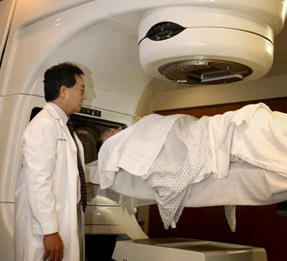Facts About Lung Cancer
- According to the American Cancer Society, in 2008 215,000 Americans learned they had lung cancer.
- Lung cancer is the second most common cancer found in both men and women.
Risk Factors for Lung Cancer
Smoking greatly increases your chances of developing lung cancer. Smoking leads to 85 percent to 90 percent of all lung cancers.
- Other risk factors include exposure to second-hand smoke, radon, asbestos, air pollution and tuberculosis.
Quitting Smoking
The health benefits begin immediately after quitting smoking.
- Quitting smoking makes treatment more effective for people with lung cancer. It also reduces the risks of infections, improves breathing and reduces the risks associated with surgery.
- Talk to your doctor or visit www.smokefree.gov to learn how to quit.
Signs and Symptoms of Lung Cancer
Some indications of lung cancer include:
- Persistent cough.
- Coughing blood.
- Shortness of breath.
- Chest pain.
- Pneumonia or bronchitis.
- Swelling of the neck and face.
- Unexplained weight loss, loss of appetite or fatigue.
Some patients may not notice any symptoms.
Diagnosing Lung Cancer
- A chest X-ray will often show a lung tumor.
- CT scans and PET scans are often used to provide more detailed information.
- To be certain if you have lung cancer, tissue from your lung will be removed to look for cancer cells. This is called a biopsy.
- The biopsy may be done during a bronchoscopy. During this test, a flexible tube with a light is inserted into your nose or mouth to look at the airways of the lungs.
- A biopsy may also be done with a thin needle inserted through the skin directly into the tumor.
Types of Lung Cancer
- Non-small cell lung cancer is the most common type of lung cancer. The most common forms of non-small cell lung cancer are squamous cell carcinoma and adenocarcinoma.
- Small cell lung cancer is less common than non-small cell lung cancer and looks different when examined under a microscope. In the past, small cell lung cancer was often called oat cell cancer.
Both types of lung cancer can spread to other parts of the body.
Treatment of Lung Cancer
Lung cancer treatment depends on several factors, including the type and size of the cancer, its location and your overall health. Surgery, radiation therapy and chemotherapy are the primary tools for treating lung cancer and may be used alone or in combination.
- Non-small cell lung cancer may be treated with radiation therapy, surgery and chemotherapy.
- Small cell lung cancer is usually treated with radiation therapy and chemotherapy.
A team of doctors will help you decide on the best treatment for you. This team may include a radiation oncologist, a medical oncologist and a surgeon.
Understanding Radiation Therapy
- Radiation therapy, sometimes called radiotherapy, is the careful use of radiation to safely and effectively treat cancer.
- Cancer doctors called radiation oncologists use radiation therapy to try to cure cancer, to control cancer growth or to relieve symptoms, such as pain.
- Radiation therapy works within cancer cells by damaging their ability to multiply. When these cells die, the body naturally eliminates them.
- Healthy cells are also affected by radiation, but they are able to repair themselves in a way cancer cells cannot.
External Beam Radiation Therapy
External beam radiation therapy targets your lung cancer. Radiation is given in a series of daily treatments, Monday through Friday. Treatments are painless and last less than 30 minutes.
- Conventional radiation therapy uses multiple radiation fields to target the cancer and keep radiation from healthy cells.
- 3-dimensional conformal radiotherapy (3D-CRT) combines multiple radiation treatment fields to deliver precise doses of radiation to the lung tumor. Tailoring each of the radiation beams to focus on the tumor targets the cancer while protecting nearby healthy tissue.
- Intensity modulated radiation therapy (IMRT) is a form of 3D-CRT that modifies the radiation by varying the intensity of each radiation beam. IMRT is still being studied for lung cancer.
- Stereotactic body radiation therapy (SBRT) is a specialized form of 3D-CRT that delivers high doses of radiation over a period of five to eight days. It is currently being evaluated for the treatment of lung cancer. This type of treatment is available at only a few centers around the country.
Internal Radiation
- Internal radiation or brachytherapy is the placement of radioactive material into or near your tumor.
- Before treatment, a bronchoscopy will be done to place one or two thin plastic tubes into your nose and into the airways of the lung.
- The tube or tubes are then connected to a brachytherapy machine. The tube serves as a channel to deliver a dose of radiation by briefly placing a tiny radioactive source near the lung tumor.
- After treatment, the tubes are removed. They may be placed again if you need more treatment.
Possible Side Effects
- Side effects are different for everyone. Some patients feel fine during treatment while others may feel uncomfortable.
- Possible problems may include skin irritation, difficulty or pain when swallowing, and fatigue.
- Lung radiation may cause shortness of breath. This may be temporary or permanent depending on your cancer and its treatment.
- With radiation therapy to the chest, you should not lose the hair on your head or have an upset stomach. Chest radiation will not affect your ability to have children.
- Talk to your doctor about any discomfort you feel. He or she can provide treatments to help.
- Everyone responds differently to the stress of cancer and treatment. Doctors, nurses, social workers and support groups are available to help.
To order hard copies of this brochure, visit the ASTRO Shop.
